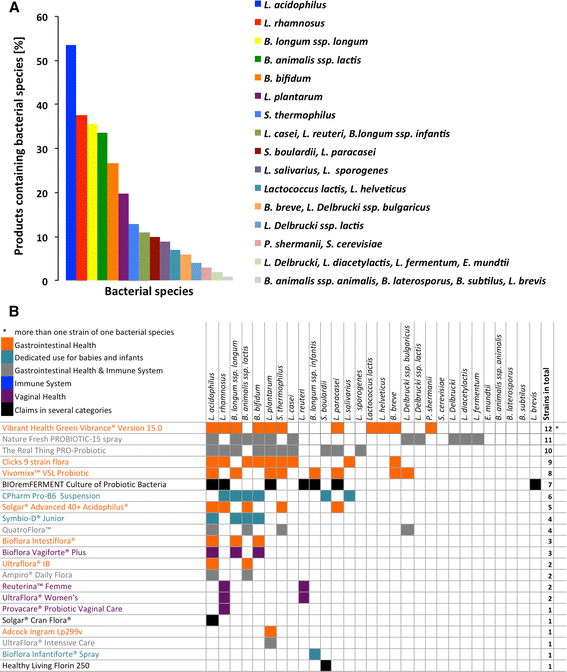Probiotics for vaginal health in South Africa: what is on retailers' shelves?
- PMID: 28103868
- PMCID: PMC5248517
- DOI: 10.1186/s12905-017-0362-6
Probiotics for vaginal health in South Africa: what is on retailers' shelves?
Abstract
Background: Probiotics are widely used to improve gastrointestinal (GI) health, but they may also be useful to prevent or treat gynaecological disorders, including bacterial vaginosis (BV) and candidiasis. BV prevalence is high in South Africa and is associated with increased HIV risk and pregnancy complications. We aimed to assess the availability of probiotics for vaginal health in retail stores (pharmacies, supermarkets and health stores) in two major cities in South Africa.
Methods: A two-stage cluster sampling strategy was used in the Durban and Cape Town metropoles. Instructions for use, microbial composition, dose, storage and manufacturers' details were recorded.
Results: A total of 104 unique probiotics were identified in Cape Town and Durban (66.4% manufactured locally). Cape Town had more products than Durban (94 versus 59 probiotics), although 47% were common between cities (49/104). Only four products were explicitly for vaginal health. The remainder were for GI health in adults (51.0%) or infants (17.3%). The predominant species seen overall included Lactobacillus acidophilus (53.5%), L. rhamnosus (37.6%), Bifidobacterium longum ssp. longum (35.6%) and B. animalis ssp. lactis (33.7%). Products for vaginal health contained only common GI probiotic species, with a combination of L. acidophilus/B. longum ssp. longum/B. bifidum, L. rhamnosus/L. reuteri or L. rhamnosus alone, despite L. crispatus, L. gasseri, and L. jensenii being the most common commensals found in the lower female reproductive tract.
Conclusion: This survey highlights the paucity of vaginal probiotics available in South Africa, where vaginal dysbiosis is common. Most vaginal products contained organisms other than female genital tract commensals.
Keywords: Lactobacillus spp.; Probiotics; Vaginal; Women.
Figures


Similar articles
-
Antimicrobial and inflammatory properties of South African clinical Lactobacillus isolates and vaginal probiotics.Sci Rep. 2019 Feb 13;9(1):1917. doi: 10.1038/s41598-018-38253-4. Sci Rep. 2019. PMID: 30760770 Free PMC article. Clinical Trial.
-
An exploratory pilot study evaluating the supplementation of standard antibiotic therapy with probiotic lactobacilli in south African women with bacterial vaginosis.BMC Infect Dis. 2019 Sep 18;19(1):824. doi: 10.1186/s12879-019-4425-1. BMC Infect Dis. 2019. PMID: 31533663 Free PMC article. Clinical Trial.
-
Oral Probiotics to Prevent Recurrent Vulvovaginal Infections During Pregnancy-Multicenter Double-Blind, Randomized, Placebo-Controlled Trial.Nutrients. 2025 Jan 27;17(3):460. doi: 10.3390/nu17030460. Nutrients. 2025. PMID: 39940318 Free PMC article. Clinical Trial.
-
Effects of probiotics on the recurrence of bacterial vaginosis: a review.J Low Genit Tract Dis. 2014 Jan;18(1):79-86. doi: 10.1097/LGT.0b013e31829156ec. J Low Genit Tract Dis. 2014. PMID: 24299970 Review.
-
Probiotics for the treatment of women with bacterial vaginosis.Clin Microbiol Infect. 2007 Jul;13(7):657-64. doi: 10.1111/j.1469-0691.2007.01688.x. Clin Microbiol Infect. 2007. PMID: 17633390 Review.
Cited by
-
Vaginal Microbiome Research Consortium for Africa: study protocol of a multicentre prospective clinical study to evaluate temporal vaginal microbial composition associated with maintenance of reproductive health in women in South Africa and Kenya.BMJ Open. 2025 Feb 22;15(2):e090938. doi: 10.1136/bmjopen-2024-090938. BMJ Open. 2025. PMID: 39987010 Free PMC article.
-
Testing the regulatory framework in South Africa - a single-blind randomized pilot trial of commercial probiotic supplementation to standard therapy in women with bacterial vaginosis.BMC Infect Dis. 2020 Jul 10;20(1):491. doi: 10.1186/s12879-020-05210-4. BMC Infect Dis. 2020. PMID: 32650729 Free PMC article. Clinical Trial.
-
Exploring potential of vaginal Lactobacillus isolates from South African women for enhancing treatment for bacterial vaginosis.PLoS Pathog. 2020 Jun 4;16(6):e1008559. doi: 10.1371/journal.ppat.1008559. eCollection 2020 Jun. PLoS Pathog. 2020. PMID: 32497109 Free PMC article. Clinical Trial.
-
Alternative and complementary therapies for vulvovaginal candidiasis.Folia Microbiol (Praha). 2019 Mar;64(2):133-141. doi: 10.1007/s12223-018-0652-x. Epub 2018 Sep 30. Folia Microbiol (Praha). 2019. PMID: 30269301 Review.
-
Safety of Probiotics: Functional Fruit Beverages and Nutraceuticals.Foods. 2020 Jul 17;9(7):947. doi: 10.3390/foods9070947. Foods. 2020. PMID: 32708933 Free PMC article. Review.
References
-
- Mittu B, Kaur B, Balgir PP. Bacterial vaginosis. Clin Microbiol. 2015;4:3.
-
- Haldar S, Kapil A, Sood S, Sengupta S. Female reproductive tract microbiome in gynecological health and problems. J Reprod Heal Med. 2016. http://dx.doi.org/10.1016/j.jrhm.2016.11.007. - DOI
-
- Kyongo JK, Crucitti T, Menten J, Hardy L, Cools P, Michiels J, et al. Cross-sectional analysis of selected genital tract immunological markers and molecular vaginal microbiota in sub-Saharan African women, with relevance to HIV risk and prevention. Clin Vaccine Immunol. 2015;22:5. doi: 10.1128/CVI.00762-14. - DOI - PMC - PubMed
MeSH terms
LinkOut - more resources
Full Text Sources
Other Literature Sources
Miscellaneous

